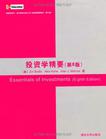投资学精要
出版时间:2011-5 出版社:清华大学出版社 作者:(美)博迪,(美)凯恩,(美)马库斯 著 页数:654
Tag标签:无
内容概要
本书由美国三位著名的金融学教授博迪、凯恩、马库斯撰写,是美国商学院和管理学院的首选教材,在世界各国都有很大的影响,被广泛采用。本书详细讲解了投资领域中的风险组织理论、资本资产定价模型、套利定价理论、市场有效性、证券评估、衍生证券等重要内容。本书观点权威,阐述详尽,结构清楚,设计独特,语言生动活泼,学生易于理解,内容上注重理论与实践的结合。
本书适合作为金融专业高年级本科生、研究生、MBA教材,也可供金融领域的研究人员,从业人员参考。
作者简介
作者:(美国)博迪(Zvi Bodie) (美国)凯恩(Alex Kane) (美国)马库斯(Alan J. Marcus)
书籍目录
第1部分投资要素
第1章投资:背景与要点
第2章资产类别与金融工具
第3章证券市场
第4章共同基金和其他投资公司
第2部分投资组合理论
第5章风险与回报:历史与序幕
第6章有效的分散化
第7章资本资产定价模型与套利定价理论
第8章有效市场假说
第9章行为金融与技术分析
第3部分债务证券
第10章债券的价格与收益
第11章债券资产组合的管理
第4部分证券分析
第12章宏观经济分析与行业分析
第13章股权估价
第14章财务报表分析
第5部分衍生市场
第15章期权市场
第16章期权定价
第17章期货市场与风险管理
第6部分积极的资产组合管理
第19章全球化与国际投资
第21章税收、通货膨胀与投资战略
附录A
附录B
章节摘录
版权页:插图:The material wealth of a society is ultimately determined by the productive capacity of itseconomy, that is, the goods and services its members can create. This capacity is a functionof the real assets of the economy: the land, buildings, equipment, and knowledge that can beused to produce goods and services. In contrast to such real assets are financial asset. such as stocks and bonds. Such securi-ties are no more than sheets of paper or, more likely, computer entries and do not contributedirectly to the productive capacity of the economy. Instead, these assets are the means by whichindividuals in well-developed economies hold their claims on real assets. Financial assets areclaims to the income generated by real assets (or claims on income from the government).If we cannot own our own auto plant (a real asset), we can still buy shares in Hondaor Toyota (financial assets) and, thereby, share in the income derived from the production ofautomobiles. While real assets generate net income to the economy, financial assets simply define theallocation of income or wealth among investors. Individuals can choose between consumingtheir wealth today or investing for the future. If they choose to invest, they may place theirwealth in financial assets by purchasing various securities. When investors buy these securi-ties from companies, the firms use the money so raised to pay for real assets, such as plant,equipment, technology, or inventory. So investors' returns on securities ultimately come fromthe income produced by the real assets that were financed by the issuance of those securities.The distinction between real and financial assets is apparent when we compare the bal-ance sheet of U.S. households, shown in Table 1.1, with the composition of national wealthin the United States, shown in Table 1.2. Household wealth includes financial assets suchas bank accounts, corporate stock, or bonds. However, these securities, which are financialassets of households, are liabilities of the issuers of the securities. For example, a bond thatyou treat as an asset because it gives you a claim on interest income and repayment of prin-cipal from Toyota is a liability of Toyota, which is obligated to make these payments to you.Your asset is Toyota's liability. Therefore, when we aggregate over all balance sheets, theseclaims cancel out, leaving only real assets as the net wealth of the economy. National wealthconsists of structures, equipment, inventories of goods, and land.You might wonder why real assets held by households in Table 1.1 amount to $26,395 billion, while total real assetsin the domestic economy (Table 1.2) are far larger, at $40,925 billion One major reason is that real assets held byfirms, for example, property, plant, and equipment, are included as financial assets of the household sector, specifitally through the value of corporate equity and other stock market investments. Another reason is that equity andstock investments in Table I, 1 are measured by market value, whereas plant and equipment in Table 1 2 are valuedat replacement cost.
编辑推荐
《投资学精要(第8版)(英文版)》:第一套根据中国工商管理本科大纲要求、教学实践进行详细精简的本科英文教材,适合中国国情及国际化双轨要求的双语教学英文教材,为中国应用型商科教育发展奠定教学模式及基础的英文版商科教材。
图书封面
图书标签Tags
无
评论、评分、阅读与下载
用户评论 (总计26条)
- 最新的教材,想留学学商科的不妨看一下
- 虽然这本书才读了一点 但是感觉无疑是本很好的 教科书 虽然是英文版 但是文字都简明易懂 适合初学者自学用 再加上是影印版 和正版内容大致一致 价格也也便宜许多 总体感觉是本值得阅读的书。
- 很不错,内容安排合理,结构合理。英文的也看习惯了
- 是影印版,纸张质量很好。只有封面有汉字,书本内容是英语。有删减,在最后两章。其他部分保留了原版精要的内容。书还是很不错的!值得一看
- 上课用的教材,凑合着看吧
- 很经典的教材,原版影印!最新版
- 是英文的哈。。。买家注意
- 很好的一本书,建议学经济金融类的同学都看一下。
- 强烈推荐,非常好看。习题很棒!适合自学
- 同时学习2个语言很不错,旅游学习必备
- 外文很专业,很厚实,需要细心啃读。
- 自己看还是太吃力!!
- 经典书籍,纸张尚可
- 书来的真快,昨天下单,今天就到了.
- 同上啊,可以买个人大的翻译过来的对比看。
- 适合本科生读,比较厚,内容较多
- 中英文对照着看,挺好
- 为什么这次拿到的书都有水浸过的痕迹?!
- 是全英的!
买错了!
真后悔1 - 放了很久,封面都变黄了。。。
- 看了一半才发现中间缺了17页,坑爹啊。。。
- 超大本的,内容很充实,但是字体较小,不过排版很nice,阅读应该很愉快,英文好的话应该比中文版的好得多,说是精简版,我看内容估计不会比原版少多少,总之,自我感觉还是不错的!!!
- 不错,就是纸质比想象中差点'很厚实
- 精要版,所以是重新编排的
- 收到这本书,是一个惊喜。和电子版一样,排版很精致,内容很丰富。得花时间细读,一定会有大收获。
- 书还OK 就是封面和纸张超级软 很容易放包里就折角了...
